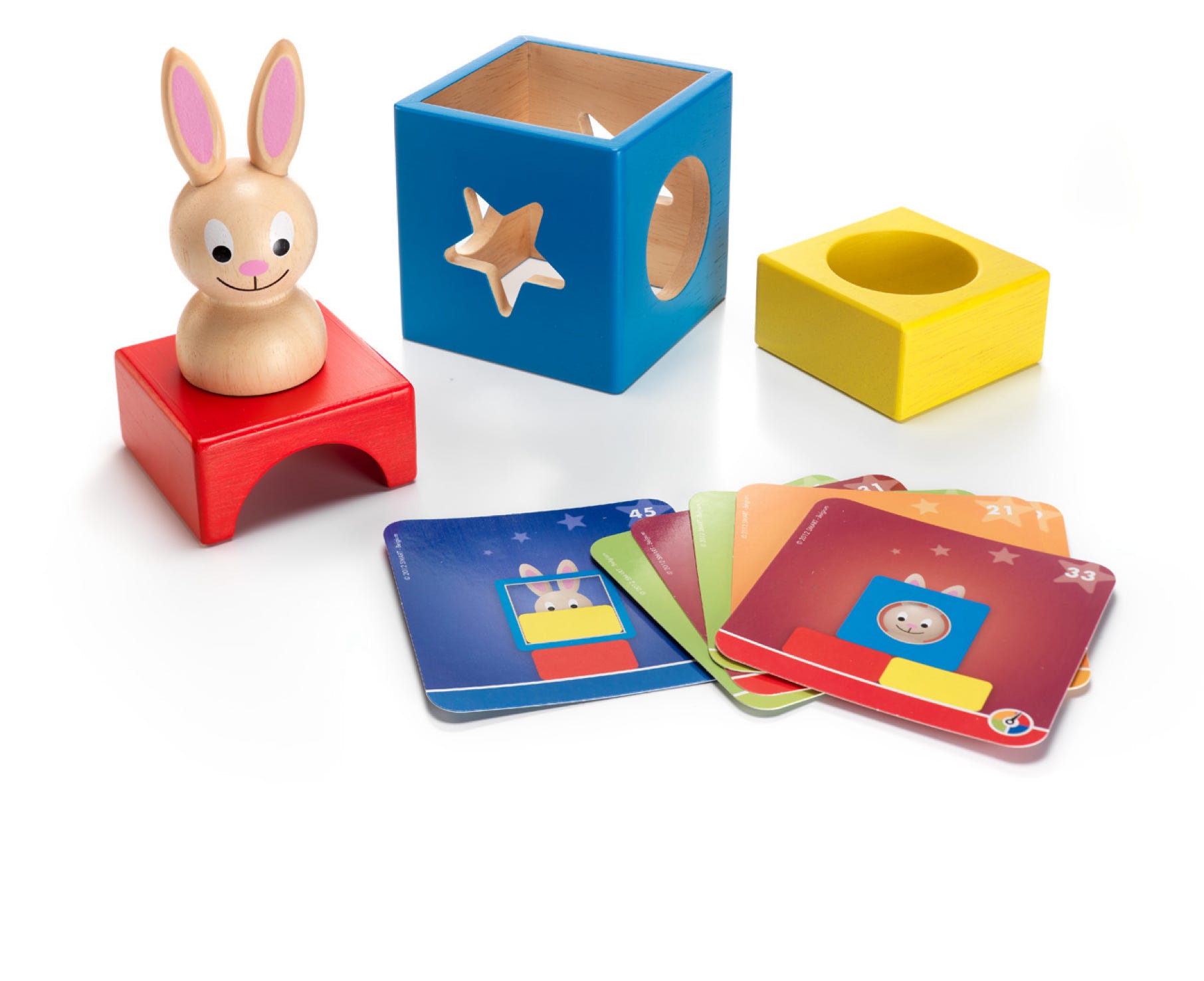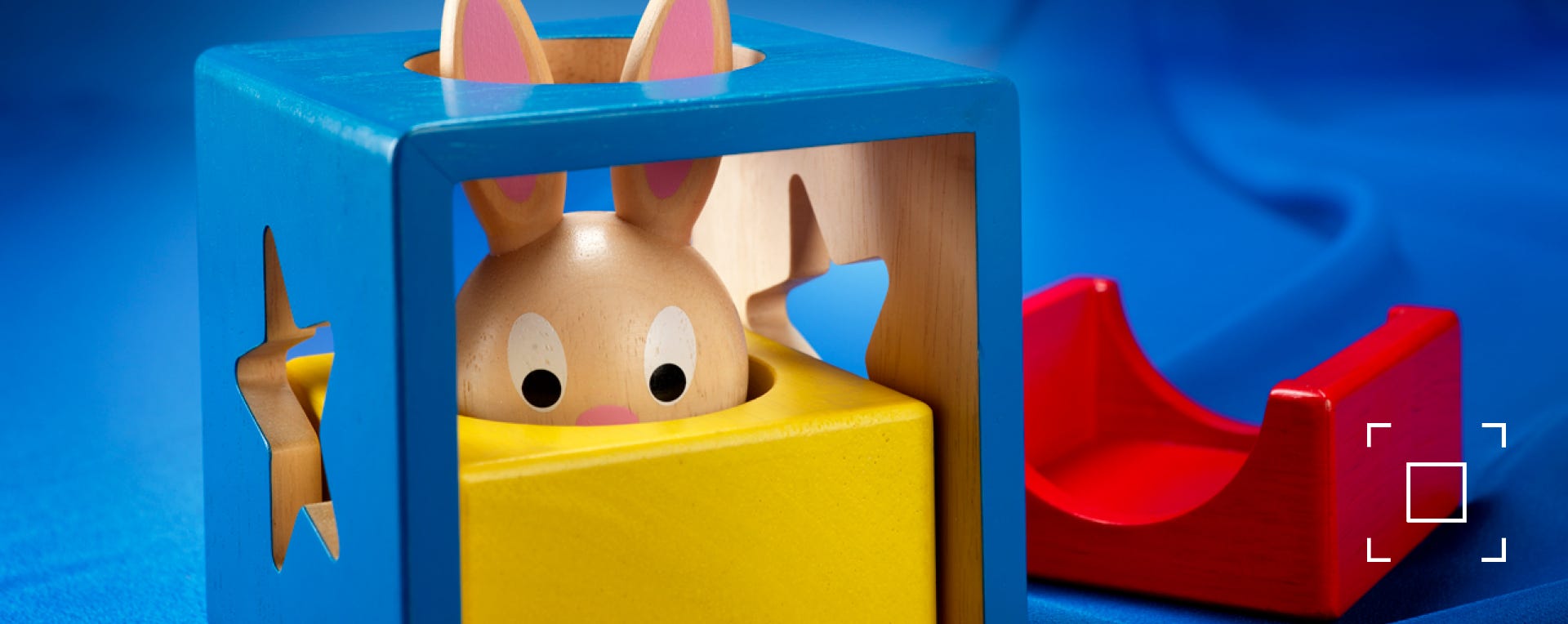Bunny Boo
The story behind the creation of Bunny Boo
Raf Peeters, January 2013
Bunny (Peek A) Boo is a wooden SmartGame for preschool children. It looks very simple and basic, but I consider it one of my best work so far.
THE STYLE
I remember very well when I got the idea for this puzzle game. I was on the way back home after a visit with my wife, children and friends to the Municipal Museum of The Hague (Netherlands). They have a large collection of work of “De Stijl” (for example Mondriaan) and at that moment there was also a temporary exhibition of Calder. The use of basic colors (red, yellow, blue) and simple shapes and that most art was very playful, inspired me. It doesn’t often happen to me, but when I was still in the car home I had a real eureka-moment. The fact that I already visited an exhibition of Dick Bruna a few weeks earlier, probably also had some influence. Not because of the rabbit, but more because basic colors and shapes also play a very important role in his books.
The rabbit was chosen later because of two other reasons. First of all, the game almost looks like a magic trick. “Pull a rabbit out of a hat” is a common phrase used in many languages, so the combination seemed logical. Secondly, I needed a figure with something that sticked out. And the ears of the rabbit were perfect for this. So intentionally, I didn’t want to do something with a rabbit. And I tried hard to make the rabbit NOT to look like “Miffy/Nijntje” from Dick Bruna (although we are all fans of his work here at home).
THINK OUTSIDE THE BOX
The object of the game is simple. Try to recreate the image shown on the challenge card (a front view) by using one or more blocks and the rabbit. It starts very simple. Children can start playing it, the moment they understand the concept of “challenges-solutions”. Some children can do that when they are 2 years old, most children need to be 3 years. It also depends on what children are used to. In Belgium children can go to school when they are 2,5 years old. So many children of that age are already familiar with “tasks”. For the challenges of the STARTER level, you only need 1 block and the rabbit. But each block has 6 sides and can be combined in many different ways with the rabbit. The blocks also have cutouts and their shape and position are not chosen arbitrary. The circular hole it too big for the rabbit to sit on it (it will fall through), but the star shaped hole isn’t. The diameter of the circular holes in the blocks are identical so the red and yellow block can become invisible when placed inside the blue block in the right way.
Challenges often come in pairs, meaning that they look very similar. Only the position of the ears is for example different. For children this can be a real eye opener. It almost seems impossible, until they learn that blocks that appear the same on the front side, can be positioned completely different.There are many more ways to combine these blocks than you would imagine. It’s also a great tool to explore with children concepts like above/below, left/right, inside/outside, etc. The game was tested in the school of my sons. All children loved it and if they were still to young to solve the challenges, they just experimented with the blocks and played “peek a boo” with the bunny.
My youngest son of age 5 helped me too with this game. He came up with a lot of different challenges than the ones I already made. What surprised me was the fact that he could imagine why other children would find his challenges hard. So maybe in the future, some SmartGames should put “author: Peeters and sons” on the box ;-)
PEEK A BOO
Young children don't understand yet what a "front view" is. You can explain it to them by making a construction on the table and make them look at it from the front, with the children's eyes at the same height as the blocks. Step away from the table. If you stand too close to the blocks, you will see more than what's visible on the challenge card, because of the perspective. The further away you look at the construction, the more the reality will match with the image shown on the challenge. For this game we didn't include the solutions on the back side of the challenge cards. The reason is that the 3D image of the solution is too complicated for young children to understand and the presence of the solution distracts them from the challenge. But for parents and teachers we included the solutions on a separate leaflet. Sometimes solutions other than the one shown on the leaflet can be correct.

2 similar examples of a starter challenge/solution of Bunny Boo with only the blue block. A small change can make a big difference.

2 similar examples of a master challenge/solution of Bunny Boo with 3 blocks. A small change can make a big difference.


GAME RULES BUNNY BOO
1) Choose a challenge. Decide which blocks you need. Put aside the block(s) you don’t need for the challenge. Their presence can be distracting, especially for young children.
2) Try to build what is shown on the challenge card, using one or more blocks and the rabbit. The construction needs to be stable.
3) You have found a solution when the front view of your construction matches the image on the challenge card.
TIPS:
It’s normal that children encounter problems when solving specific challenges. Things that might be obvious for adults are not obvious for them. Difficulties are opportunities to learn something new. You don’t help children by solving the challenges yourself, but by asking questions, like:
• “Where do you think this block goes?”
• “Why do you think this block needs to be placed like this?”
Young children don’t understand yet what a “front view” is. Explain it to them by making a construction on the table and make them look at it from the front, with the children’s eyes at the same height as the blocks. Step away from the table. If you stand too close to the blocks, you will see more than what’s visible on the challenge card, because of the perspective. The further away you look at the construction, the more the reality will match with the image shown on the challenge.
For this game we didn’t include the solutions on the back side of the challenge cards. The reason is that the 3D image of the solution is too complicated for young children to understand and the presence of the solution distracts them from the challenge. But for parents and teachers we included the solutions on a separate leaflet. Sometimes solutions other than the one shown on the leaflet can also be correct.
Website ©2013 Raf Peeters
Products and images: © Smart
